Khedivial Hunting Lodge Turned Hotel
Samir Raafat
Cairo Times, April 3, 1997
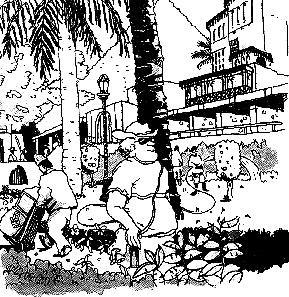
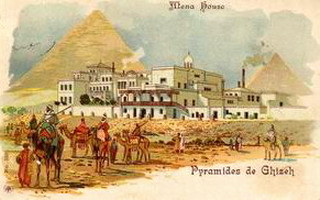
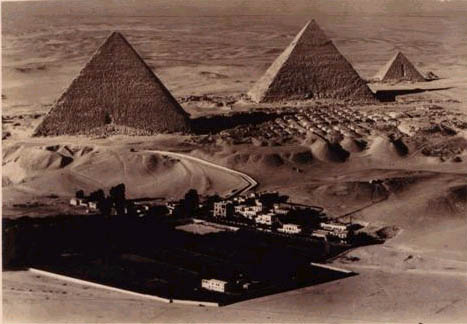
aerial photo of pyramids courtesy of Judith MacBeth
photo taken during WW2 an Allied army camp at foot of second pyramid
|
|
|
|
|
Cheers to our "talented" literature prize awardee. Your pain his gain !!!
|
|
|
EGY.COM - GIZA
|
|
Samir Raafat
Cairo Times, April 3, 1997



aerial photo of pyramids courtesy of Judith MacBeth
photo taken during WW2 an Allied army camp at foot of second pyramid
MENA HOUSE was originally Khedive Ismail's (r. 1863-79) rest house cum hunting lodge, its core being what is today the Oberoi Hotel's arabesque dining room.
The first hote de marque to visit the lodge was Empress Eugenie of France when she attended the November 17, 1869 opening celebrations of the Suez Canal. It was during her sojourn that the Pyramids Road was created. The grateful Empress offered her munificent host Acacia trees which he planted on either side of this once world-famous avenue.
When she revisited the site in 1909, Eugenie was no longer Empress of France and the khedivial lodge had been replaced by an hotel. Eucalyptus trees were now bordering the avenue. Unchanged however was the setting which remained just as sensationally beautiful. The gardens of the lodge-turned- hotel still burst with roses, oleanders and magnolias all of them looking out towards the great pyramids.
Between Eugenie's only two visits, France had abandoned Emperor Napoleon and Khedive Ismail lost Egypt. The latter's Giza hunting lodge had been picked up by the Englishman Frederick Heads and his wife Mary the Australian daughter of Queensland Treasurer of 1866, John Donald McLean. They named it 'Mena House' in honor of King Mena who is listed on the tablet of Abydos.
After the death of Mr. Head, the former hunting lodge became home to Hugh and Ethel Locke-King. Ethel too, knew Australia well, for her father had been Tasmania's Governor of the 1860s, Sir Thomas Gore Brown. The Kings undertook major structural changes such as installing fire places and giving the place an Englishy look sharply deviating from the prevailing Ottoman decor characterized by mother of pearl arabesques and masharabeyas. Large public rooms, terraces and verandahs were also added. Car racing fanatics in England, the Locke-Kings added motor car gymkhanas to the hotel's social calendar of events. Managing the hotel on their behalf was Baron de Radokawsky.
After the Locke-Kings, Mena House, by now a well established hotel, was managed in turn by a Mr. Klinger and then by Emil Weckel whose annual fancy dress ball and his Sunday and Wednesday concerts were novel attractions to the already popular hotel. Others amenities included a golf course, two croquet lawns and, horses and donkey for hire.
A pre WW1 description of the hotel sums it up in the following terms: "At the foot of the pyramids, on the borders of the Desert, is one of the finest hotels in Egypt, Mena House. At tea-hour its terraces are crowded with a gay and brilliant throng. The large and comfortable salons, the delicious Moorish dining room, the excellent food, the open air-swimming bath, the golf course, the tennis courts, the croquet lawns all go to make a stay at Mena House one of the most pleasant incidents of a trip to Egypt."
A sporting event at the Mena House Hotel which fascinated the First Australian Division camping nearby during WW1, was the camel races, especially when a camel, furious at being passed, would sink his teeth in the leg of the jockey of his most speedy rival, biting it with fury. If he were lucky, he would then be taken to the Mena House which had become a hospital during most of WW1 staffed by Anzac nurses.
During the interwar period, the 150-room Mena House was managed by the Egyptian Hotels Company (EHC) which succeeded the George Nungovich Co. (also the managers of Shepheard's in Cairo, the Old Cataract in Aswan). Under the directorship of its veteran Swiss hotelier Charles Baehler, EHC multiplied the rooms, added a swimming pool and extended the overall facilities.
Like The Ritz in Paris, The Plaza in New York and the Claridge's in London, Cairo's Mena House, being the only hotel in the vicinity of the pyramids up to the 1960s, hosted every emperor, king, president, general, business tycoon and megastar who visited Egypt. Enemies-to-the-death and wartime allies stayed there between 1939-14 including Josef Goebbels, Franklyn Roosevelt, Winston Churchill and Generalissimo Chiang Kai Chek. The last three hammered out at Mena House the final plans for a wholesale victory over Germany and Italy.
Exiled kings made Mena House their temporary home including King George of the Hellenes who stayed there with his English mistress.
After WW2, the Egyptian Hotels Company (EHC) resolved to give its five-star properties a much overdue overhaul. Supervising the decoration of two of them - Cairo's Mena House and Jerusalem's King David - was hotel consultant, Denise Dreyfus, daughter of Cairo financier Elie Mosseri who held considerable interest in EHC.
Both hotels, each set in a historically dramatic location, were ultimately confiscated. The first was taken over by the government of Egypt when private companies were axed under the new-sprung socialist laws and the second when the government of the new state of Israel expropriated all Egyptian-owned assets.
The first Egypto-Israeli Peace Talks were held at the Mena House in the late 1970s. By then, the much transformed hotel had become a member of a leading Indian hotel chain.
The Bombay-based Oberoi Hotels Group manages the Mena House to this day.
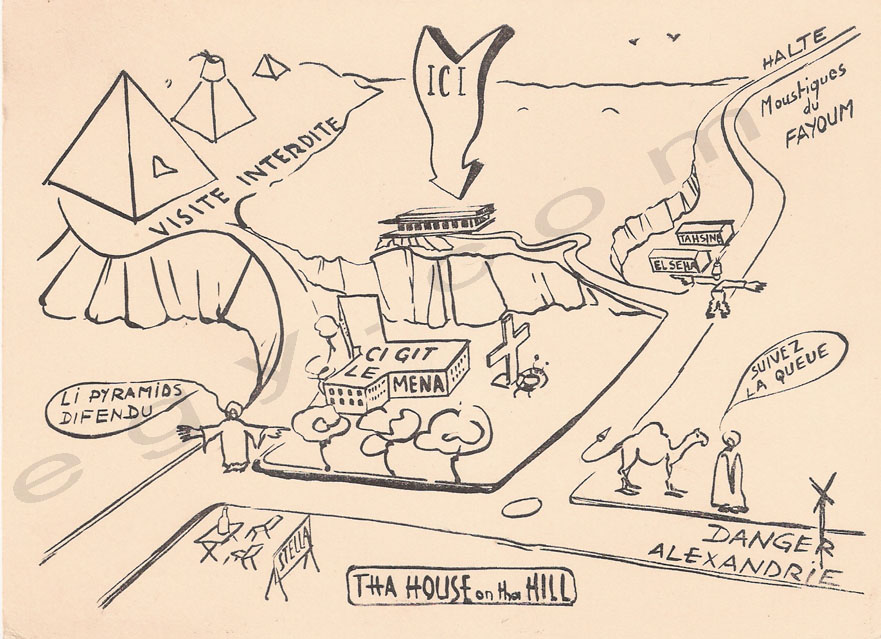
One of the earliest nightlife spots next to the Giza Pyramids/Mena House complex was the 1960s Stereo al-Ahram dancing hall launched by Mr. R Saiid. Located on top of a sandy hill just north of the Pyramids (see photo above) it was originally the weekend home of the Debbas family, Elie "Loulou" Debbas and Betsy G.Takla (granddaughter of al-Ahram's founder which eventually became Egypt's leading daily newspaper).
Front and back of house launch invitation card addressed to Dr & Mrs Wahid Raafat telling the story with a wonderful characterization of the contemporary 1950s landmarks...
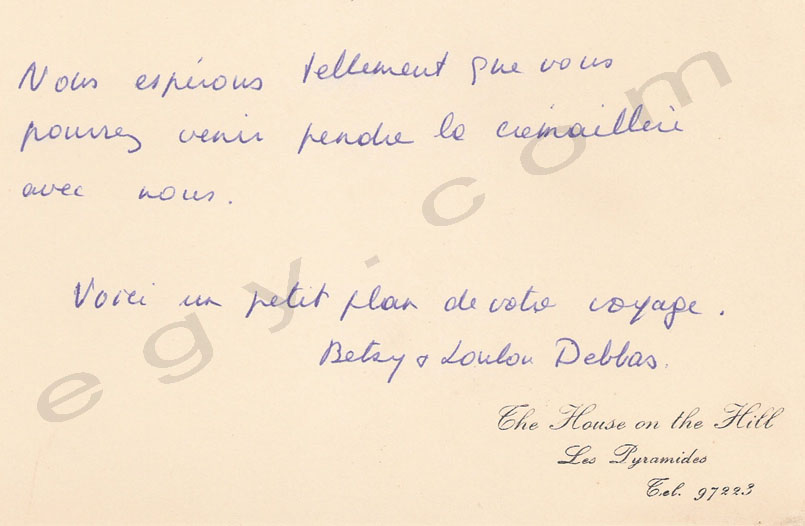
|
|
|
|